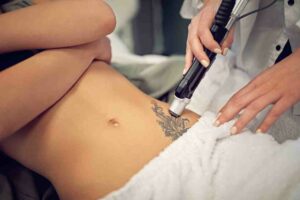Do you know that scars and tattoos have several similarities? Tattooing over scars and stretch marks is the best and most popular way to hide scars. Scars can have positive memories, while in other cases they have depressive and suicidal episodes. Some persons wear their scars with pride while others decide to hide theirs. Either of the choices is perfect and is up to the individuals involved.
Concerning stretch marks, tattooing over stretch marks is one way of concealing the mark partially or entirely. These stretch marks often appear where individuals would have loved to get their tattoos drawn.
They are common aesthetic problems, particularly among women. Depending on the location and type of scar involved, most tattoo artists are hesitant about dealing with cases of keloids since they tend to absorb ink a lot and require a lot of skill.
Artists normally find it very challenging to ink over stretch marks especially when they appear too much. Covering stretch marks has now become a prominent fashion statement across the world. People tattoo their skin or embark on a second tattoo journey only to hide their scars or stretch marks.
Stop being the curious French cat and take a look at everything that has to deal with tattoos on scars covering any type of scar.
Ensure you read till the end.
Why Do People Get Tattoos on Scars?
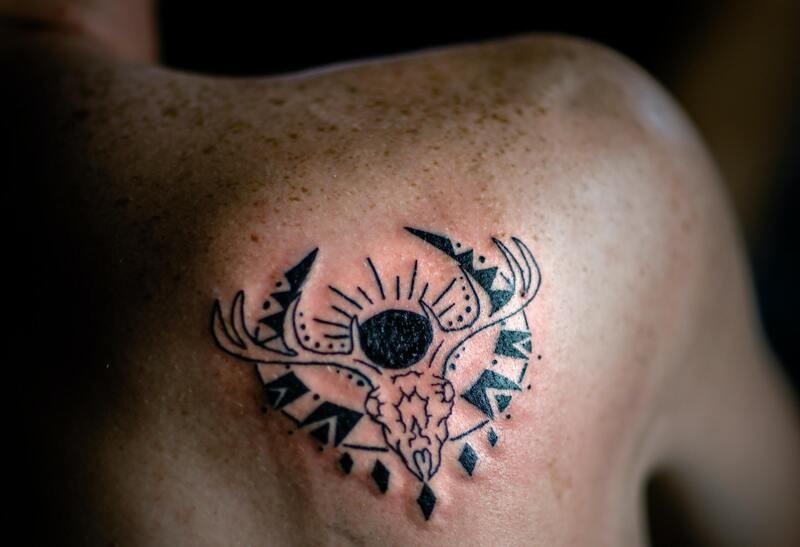
People who have scarred skin can find it hard to get a tattoo done, especially if they are somewhere apparent, hence booking a tattooing session with an artist and getting a scar-covering tattoo is an outstanding choice.
Scar-covering tattoos go a long way in bringing back the confidence that the individual has lost through any negatively experienced incidence of scar tissue. Not all tattoo stories are negative, some toughened scar tissue you might have seen today also carries positive memories.
People tattoo their deeper scars for entirely different things or reasons. Some decided to get tattooed after obtaining a deep scar, left by the possibility of many surgeries that they have gone through. They range from mastectomy to skin removal scars to breast cancer to atheroma removal to skin cancer.
Here is our absolute favorite poet that phrase as an element of motivation and conveys a meaningful message for people who are just overcoming the aftermath of a deeper scar:
To make a very long story short, I have gone through many operations, severe allergies, and overall tons of health challenges all my life. Suicide could’ve taken my life. The number one reaction I hate getting when I was in the seventh grade is one like poor Lauren, that’s so terrible, I am feeling so bad for you. I don’t like to be pitied and felt so sorry over issues that I cannot control. I was born with what life gave me and I have always just dealt with it without sitting around and feeling sorry for myself or wanting pity from others.
Well said, dear Lauren. The aforementioned was obtained from a group of peer-reviewed studies to motivate you. It’s one of the popular articles that cover beautiful things, journeys, photos, comments, and life.
is it More Painful to have tattoos over scars?
It is very painful to make tattoos on scars. Although it is not impossible, it is simply depending on the texture of the scar tissue to be tattooed as well as the type of scar that requires a tattoo.
Generally, a scar symbolizes the healing of an initial wound. Everyone indeed has a different level of pain tolerance that’s why different people can bear pain more than others. However, experts have given their honest opinion that as a thumb rule, a scar covering a tattoo is more painful when compared to getting a tattoo on unscarred skin.
Scars or presumably deeper scars are often painful when being tattooed, while tattooing over mild scarring is a bit less painful since they are only smaller scars that lie almost flat to the skin and remain in the same region where the old tattoo wound was.
If you are in search of tattoo designs to use over your scar or stretch mark, ask your tattoo artist to give you ideas on designs that can cover your scar tissues, including geometric shapes and tattoos.
This is often more severe for people with scars that have caused nerve damage. Here we have listed some most common scars, people choose to have tattoos over them:
Tattoos over Atrophic scars
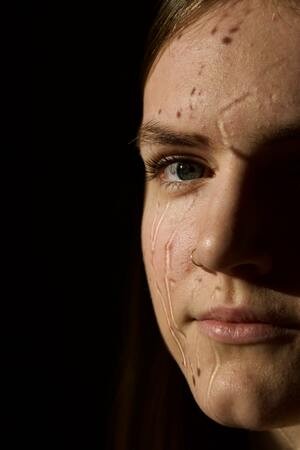
Atrophic scars are normally looking whitish and soft. The location is often at the end of deep scars obtained from simple surgeries, burns, and deep cuts.
The stretch mark too is not left out of this category. Take, for example, the stretching of the entire stomach from the abdomen that a pregnant woman has passed through before she was born to her little one. The same can be said for some men too whose arm region also shows the strain of stretch marks. It is safe to draw tattoos over atrophic scars once you observe that the healing process of your scar is completed.
Because they are often discolored and don’t blend with your skin tone. You might find it a bit challenging to get a design that will cover this scar tissue completely and smoothly.
Your tattoo artist can get you inspired to choose among the preferences designs that will work best for your scar tissue.
Tattoos over Hypertrophic scars
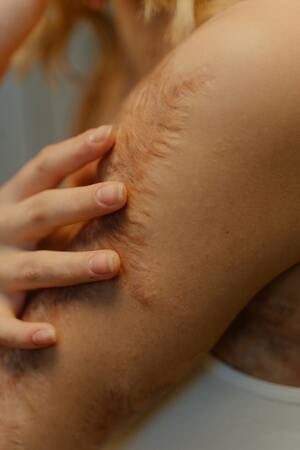
It is normal to confuse hypertrophic scars for keloid scars because they tend to look alike, but on the contrary, they are not. Hypertrophic scars occur when there is a lot of tension on a tattoo wound that is still healing.
This often makes the scar look thicker than before. However, hypertrophic scars are visible only in the round region of the scars.
Tattoos over Keloid Scars
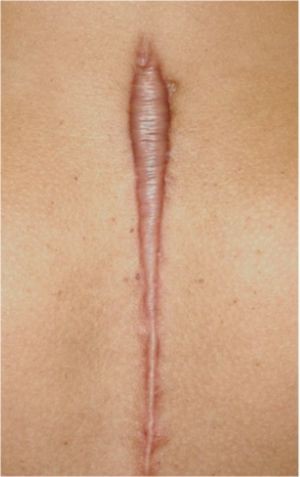
Keloid scars are raised type of scars that comprises cells that help in repairing the damaged area of your skin whenever there is an injury. Keloid can form over skin injuries spread from cuts daily, burns, insect bites, and tattoos. Most especially at the edges of fresh scars. Keloids have a shiny and smooth surface and when they occur, you are likely to itch since they hurt.
If you decide to get a tattoo over the keloids it is best to wait at least one year to ensure that the scar is completely healed otherwise, you might injure or reopen your skin again.
The process of inking over a keloid scar is known as scar tattooing. It involves a lot of skill and time to get the keloids safely inked.
Tattoos Over Burn Scars
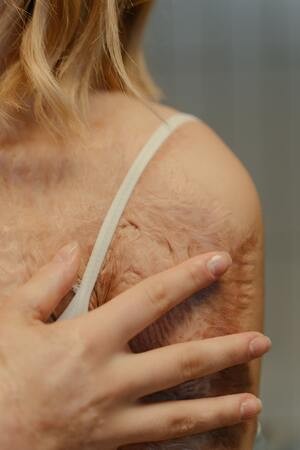
Usually, burn scars are more sensitive and irregular than others. In such circumstances, it would be more tricky to have tattoos over burn scars and need more professionalism for a tattoo artist. The tattoo artist should be more vigilant while choosing the design and the color combination for tattooing over burn scars.
Potential Risks and Things to be kept in Mind While having tattoos over scars
Before you get a tattoo over the scars, it is important to let your scar tissue heal properly. Once it is fully healed you can then progress into getting that beautiful tattoo over scars.
The challenges involved in tattooing over a scar, particularly if the healing stage of the injuries is not yet over, are the irregular shape of the scar, illness of the individual, blurring of the eyesight, irritated skin, red skin surface, and more.
The scar also risks being prone to illness and symbolizes self-harm to the person when the details of the tattoo are being done shabbily. Here are some more difficulties that can be faced while thinking of a scar-covering tattoo:
Professional Tattoo Artist
As well know that tattooing over scars is a little bit more tricky than the normal tattooing process and requires a more experienced tattoo artist. So, the first and foremost requirement for tattooing over scars is a professional tattoo artist. He/She should have experience in tattooing over scars and should be capable enough to handle the issues and complications arising during the entire process.
Color of Scar
The color of the scar must be assessed before the tattooing session. As we all understand that a red scar is more difficult to get tattooed over it compared to pale scars. If it is red in color then it might be very tricky to conceal.
Type and Location of Scars
It is very essential to assess the type of scar before thinking of tattoo over it. The scars with darker edges are difficult to have tattoos over them compared to the scars without edges. Apart from this, the location of the scar should also be assessed for the suitability of the tattoo.
Scars Could Bleed
Usually, scars stiffen your skin and make the outer skin shells irregular. Consequently, scarred skin is less able to absorb ink than unscarred skin resulting in more irregularly soothing in scar tissue than it does in unscarred skin.
Therefore, there might be chances that the ink in a scar-covering tattoo will ooze, causing your tattoo to look ugly and bleeding.
Is The Scar Fully Healed
Acne scars are often soft in touch and have a lighter tone than other scars. Though it is totally safe to tattoo over atrophic scars only if they are healed properly. The skin over the atrophic scars could be discolored and mismatched regular skin tone resulting in a bigger challenge to choose the perfect tattoo design.
Tattoo Could Cause More Scars
Keloid scars are thicker than others and red in color with a raised and irregular shape. Sometimes it may take longer to build scar tissue after the initial injury. In such cases of keloid scars, there might be chances of getting the scars to worsen while having tattoos over them. To avoid such a situation it is advisable to wait for at least 4 to 5 years before proceeding with tattooing over keloid scars.
Design of Tattoo
Selecting a tattoo design is always tricky. However, it would be more difficult in the cases of tattoos over scars that can creatively cover or work around the scar. It is to be kept in mind that the scarred skin will be always irregular compared to the normal skin and the texture of the tattoo can be disturbed if not chosen wisely.
Get Ready for Pain
As we have mentioned earlier that it is really more painful to have tattoos over scars than tattoos on normal skin. So it would be better to be mentally prepared for the pain while going for the tattoo sessions. Normally the healed scars can have lesser pain than fresh scars.
Follow the Aftercare Tips
Be sure to follow the aftercare tips for the better and timely healing of any tattoo and to use top-rated lotion or ointments for better results. Visit the tattoo parlor regularly for the inspection of fresh ink and follow the advice given by your tattoo artist. Else, you can consult a medical specialist also if things are getting worse.
Is tattooing over scars Different From coverup tattoos?
Getting a tattoo over scars can be a result of different reasons. However, you can draw tattoos to cover your gnarly scar.
Tattoos over scars and coverup tattoos are entirely different from each other and can be quite tricky since the procedure requires experience and skill to carry out. This is why it should be done by an experienced tattoo artist.
Tattoos over scars are the art to cover the scars due to some injuries while cover-up tattoos are tattoos to hide unwanted art or past experiences. However, they are both scar camouflage procedures that act as just a tattoo on the skin’s surface.
Tattoos over scars are done for a person who has a mild scar, a small cut, or superficial scars and is not a bit feathered by the infection, and the irritation that comes alongside it. In the context of coverup tattoos, people choose to disguise or cover their existing tattoos with beautiful tattoos due to different reasons.
Most persons want their scarring injury not only to be fully healed but also quickly turned in appearance into a lovely piece of art. The challenging part of both processes is knowing if the body part that carries the main scar is stretched enough to take on a new tattoo.
Let your tattoo artist be aware of the type of scar tissue you have before your skin absorbs ink again. This is to ensure that your tattoo scar has fully healed and to avert a newer scar from forming again.
Frequently Asked Questions: Tattooing Over Scars
Is it Safe to Tattoo Over Scars?
Yes, it is safe to do so when you engage the services of a skilled tattoo artist who will cautiously carry out the process.
Apart from this, when you see any sign such as a red depth of skin textured around the tattoo region that remains persistent for weeks and doesn’t go away. Seek medical help.
Does Tattooing Over Scars Hurt?
Yes, it does hurt. Once you are done tattooing over scars, pain is inevitable but the result is amazing. All you need to do is to do regular follow-ups as your tattoo artist might have advised.
Are Tattoos a Good Option for Covering Scars?
Yes, they are, but not in all cases, as some can even result in severely adverse conditions that can pose a dangerous threat to your tattoo.
Talk to your artist as regards your scar, to know the best results that will be fine for your skin type in preparation for your scar covering tattoos.
How Long Should You Wait Before Tattooing Over Scars?
For example, your scar presently can be likened to a traditional furniture decoration. People wear tattooed coverings for cultural reasons which symbolize healing over the pain they once endured and they don’t want to answer any more self-harm but assess all this anger built into a meaningful message.
This is why you have to wait at least one year to heal before deciding to get tattooed raised as scar covering tattoos.
Conclusion
From the aforementioned, now you can see both the good and bad sides of getting a tattooed cover over a scar.
Getting a higher chance to accept and cover your scar with a tattoo, for instance, in places such as either your arm, leg, or neck can be quite awesome. Once the closure of the tattoo is done successfully, your newly painted arm or Sylvia Plath tattoo is ready to be flaunted.
You can visit any peer review group page on Instagram on your device and get to see a beautiful photo and read various articles that will motivate you to break from self-harm addiction.



